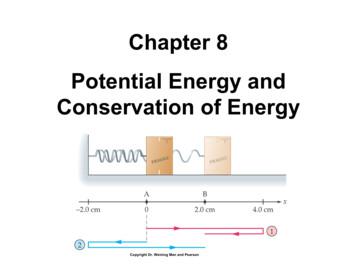Electric Potential, Electric Potential Energy And Capacitance
Electric Potential EnergyElectric Potential,Electric Potential Energyand CapacitanceConservation of EnergyPotential of Point ChargesEquipotential SurfacesChapter 18Capacitance & Capacitors2Energy: DefinitionsWebster’s dictionary:Part 1Energy – the capacity to do workWork – the transfer of energyElectric Potential EnergyRichard Feynman – Nobel Prize in physics (1965)The Feynman Lectures on Physics. “.in physicstoday, we have no knowledge of what energy is.”We know how to calculate its value for a great varietyof situations, but beyond that it’s just an abstract thingwhich has only one really important property 4conservationPhysics 111: Potential EnergyConnection between energy and force - hintPotential energy U is energy that can be associated withthe configuration of a system of objects that exert forceson one another. If the configuration of the system changes,then the potential energy of the system can also changePotential energy can be defined for conservative forces onlyExamples: gravitational potential energy spring elastic potential energymv 2 mv02v 2 v02 2a ( x x0 ) 221ΔK m( v 2 v02 ) ma ( x x0 )21 2 1 2mv mv0 F ( x x0 )22ΔK Left side – the kinetic energy has been changedRight side – the change is equal to Fx·d5W F ( x x0 )61
Similarities between Coulomb’s law andConnection between a conservative force andNewton’s gravitational lawpotential energyEquations are similarThe change in potential energy dues to the change inconfigurationCalculus based physicsFg Gm1m2r2Fc kq1q2r2xfΔU F ( x )dxBoth forces are conservative ones.Conservative force:Definition 1. A conservative force does zero total workon any closed pathDefinition 2. The work done by a conservative force ingoing from an arbitrary point A to an arbitrary point B isindependent of the path from A to B7xiAlgebra based physics (gravitational and spring forces)ΔU mgh F mg1ΔU kx 2 F kx28Definition for electric potential energyDefinition for electric potentialElectric potential energy can be defined similar todefinition of the gravitational potential energyPotential energy changeElectric potential is not the same as Electric potentialenergy but the connection is very simpleFor applications it is very useful to introduce the potentialenergy per unit chargeU a U b Fd U b q0 EdaΔV bF q0 EUnits: J/C (the joule per coulomb),1 volt 1 joule per coulombwith this definition E N/C V/mElectric potential is a scalar, not a vectorEd is the distance between points a and bDefinition is true for a constant electric force working9along the path of the motion.Confusion with definitions for “change inelectric potential”, and “change in electricpotential energy”and1. Always draw a diagram with fields and forces2. Mark initial and final points3. Watch the field direction and the sign of the chargeΔx x f xiIn the textbook the change is defined asThereforeΔU U U q Ed a F q0 Eba10Helpful approach (less confusion)There are two definitions for a “change of something”Δx xi x fΔUq0EF q Ea b0F q EdΔV Vb Va EdE11bU a U b q Ed-U a U b q Edin most textbooksΔU U b U a q Ed122
Four possible combinationsbluefieldredforcegreen displacementChange in electric potential energy.(notice the direction of the blue arrow.)1. A positive particle moves in the direction of theelectric field Potential energy decreases2. A positive particle moves opposite to the direction of the electric fieldPotential energy increases3. A negative particle moves in the direction of theelectric fieldPotential energy increases4. A positive particle moves opposite to the direction ofthe electric fieldPotential energy decreases1314More terminologyFor a uniform field (E const) and 1D caseElectric potential energy (U):potential energyelectrostatic potential energyElectric potential (V):potentialpotential differencevoltage (difference)electrostatic potential1516The zero of electrical potentialFor calculating physical quantities it is the difference inpotential which has significance, not the potential itself.Therefore, we are free to choose as having zero potentialany arbitrary point which is convenient.Typical choices are: the earth infinityPart 2Conservation of Energy173
problemProblemConservation of energyA consequence of the fact that electric force isconservative is that the total energy of an object isconserved (as long as non-conservative forces like frictioncan be ignored)Ka U a Kb U b1 21mva qVa mvb2 qVb221920?Net PotentialThree possible configurations for an electron e and a proton p areshown below. Take the zero of potential to be at infinity and rankthe three configurations according to the potential at S, from mostnegative to most positive.A)1, 2, 3B)3, 2, 1C)2, 3, 1D)1 and 2 tie, then 3E)1 and 3 tie, then 2problemProblemA charge q (q 6.24 μC) is released from rest at the positiveplate and reaches the negative plate with a speed of 3.4 m/s.The plates are connected to a 12-V batteryCalculate:(a) the mass of the charge.(b) its kinetic energy at point A and at point B.(c) If d 2cm, what is the electric field between the plates?21ProblemproblemA uniform electric field with a magnitude of 1200 N/C points in thenegative x direction.(a) What is the difference in electric potential ΔV Vb-Va betweenpoints a and b(b) What is the difference ΔV Vb-Vc ?(c) What is the difference ΔV Vc-Va ?(d) If a particle with mass of 3.5 g and a charge 0.045μC is releasedfrom rest at point A, in what direction it will move?(e) What speed will be after moving through a distance of 5 cm?Let’s discuss this!22Part 3The Electric Potential ofPoint Charges234
For a point electric chargeThe electric potential of point chargesThe difference in electric potential energy and electricpotential between two points can be written asUa Ub kq0 qqq k 0rarbVa Vb kqq krarbSince the potential can be set to zero at any location, wechoose the electric potential to be zero infinitively farfrom a given origin (Vb 0 as rb )ThusU kq0 q q0VrV kqr2526Many Charges and SuperpositionIf we wish to know the potential at a given point inspace which results from all surrounding charges, wesimply add up the potential at that point due to eachcharge:Three possible configurations for an electron e and a proton p areshown below. Take the zero of potential to be at infinity and rankthe three configurations according to the potential at S, from mostnegative to most positive.A)1, 2, 3B)3, 2, 1C)2, 3, 1D)1 and 2 tie, then 3E)1 and 3 tie, then 2Note that because potential is a scalar, the summationis not difficult. We just need to insert the sign of eachcharge.VA k?Net Potentialqqq1 k 2 k 3 .r1r2r32728How many grains form a pile of sand?One protonA proton is released from rest in a region of spacewith non-zero electric field. As the proton moves,does the electric potential energy of the protonincrease, decrease or stay the same? Explain.?Two protonsTwo protons are released from rest when they areD nm apart. After being released(a) their kinetic energies gradually decrease to zeroas they move apart(b) their kinetic energies increase as they moveapart(c) their electric potential energy graduallydecreases to zero as they move apart29(d) their electric potential energy increase as theymove apart305
?Two protons (more)Two protons are released from rest when they areD nm apart.(a) What is the maximum speed they will reach?(b) What is the maximum acceleration they willachieve?(c) When does this acceleration occur?(d) Will the answers to questions a-c be different ifwe consider two electrons?(e) What if we have an electron and a proton?The Electron VoltIt is often convenient to work with a unit of energycalled the electron volt.One electron volt is defined as the amount ofenergy an electron (with charge e) gains whenaccelerated through a potential difference of -1 V:1 eV (1.6 x 10-19 C)V 1.6 x 10-19 J3132Equipotential SurfacesPart 4A surface in space for which the potential is thesame everywhere (like the surface of a conductor) iscalled an equipotential surface.Equipotential SurfacesSince no work is required to move a charge on anequipotential surface, the electric field at everypoint on an equipotential surface is perpendicular tothe surface.34Equipotentials for a point chargeEquipotential surfaces fora uniform electric field35Equipotential surfaces for two point charges366
Capacitance and CapacitorsStoring energy as potential energy:stretching a springlifting a bookpulling a bowstringWe can also store energy as potential energy in anelectric field.Capacitor is a device that is used to do that.Part 5Capacitance & Capacitors38A Simple CapacitorDefinition for CapacitanceTwo charges (with equal but opposite charges ofmagnitude q)The charge and the potential difference V for a capacitorare proportional to each other q CV-Why is that?The proportional constant C is called the capacitance ofthe capacitor.Its value depends only on the geometry of the plates andnot on their charge or potential differenceSI unit: coulomb/volt farad, FConnection: energy - potential differenceVa Vb kq1qq k 2 2krarbr39Charging a capacitor40Capacitance for different geometriesTwo conductors (conductingplates) connected to a battery.Conductors: negative charge canmove rather freely.A parallel plate capacitorC ε0 AdA – the plate aread – the plate separationε0 – the permittivity constantε0 8.85*10-12F/m 8.85*10-12C2/N·m2There are definitions for other geometriesGauss’s law is the toll to calculate.41427
?QuestionA capacitor C "has a charge Q". The actual charges on itsplates are:A)Q, QB)Q/2, Q/2C)Q, –QD)Q/2, –Q/2E)Q, 0Energy stored in an electric fieldElectric potential energy of a charged capacitorU q2 11qV CV 222C 2The potential energy of a charged capacitor may be viewedas being stored in the electric field between its plates43Capacitor with dielectric44?QuestionDielectric: insulating material(plastic, paper )A parallel-plate capacitor is attached to a battery thatmaintains a constant potential difference V between theplates. While the battery is still connected, a glass slab isinsertedso as to just fill the space between theplates. The stored energy1. increases.2. decreases.3. remains the same.C κ C0k is the dielectric nia ceramic130.045468
Potential energy can be defined for conservative forces only Examples: gravitational potential energy spring elastic potential energy 6 Connection between energy and force - hint Left side – the kinetic energy has been
reduces Kinetic Energy and increase Potential Energy A: The energy is stored as potential energy. PE is like your saving account. Potential energy gain (mg h) during the rising part. We can get that energy back as kinetic E if the ball falls back off. During falling, Kinetic Energy will increase mg h. Potential energy will reduce mg h.
Analysis: Calculate the final electric potential energy using 1the equation E Ei kqq 2 r f. The initial kinetic energy of each proton is 1 2 mv2, and the initial potential energy and final kinetic energy are both 0. Use the conservation of energy to determine the final separation of the protons. E Ei E ki E Ef E kf 0 1 2 m 1 v i1 2 1 2 m .
Energy comes in many forms, but rollercoasters mostly use Potential Energy and Kinetic Energy. Potential Energy is stored energy. Rollercoasters use gravitational potential energy which is stored when objects go up high. The equation for gravitational potential energy is Kinetic Energy is the energy of a moving object.
Which idea describes a change from potential energy to kinetic energy? 4. Not all of a roller coaster’s energy transfers back and forth between potential energy and kinetic energy. According to the law of conservation of energy, however, the leftover potential energy must exist somewhere. Identify another form of energy that both potential .
on work, power and energy]. (iv)Different types of energy (e.g., chemical energy, Mechanical energy, heat energy, electrical energy, nuclear energy, sound energy, light energy). Mechanical energy: potential energy U mgh (derivation included ) gravitational PE, examples; kinetic energy
Electric Potential Energy in a Uniform Field: - When a charged particle moves in an electric field, the field exerts a force that can do work on the particle. The work can be expressed in terms of electric potential energy. - Electric potential energy depends only on the p
Kinetic vs. Potential Energy Potential Energy is the energy an object possesses by virtue of its position or composition. Kinetic Energy is the energy of motion K.E. ½mv 2 where m mass and v velocity Notes 6.1 2c Initial vs. Final Position In the initial position, ball A has a higher potential energy than ball B.
Human Factors and Usability Engineering – Guidance on the regulation of Medical Devices Including Drug-device Combination Products in Great Britain Version 2.0 January 2021 . Human Factors and Usability Engineering – Guidance for Medical Devices Including Drug-device Combination Products MHRA September 2017 v1.0 Page 2 of 35 Contents 1 Introduction and context . 4 2 The regulatory .























